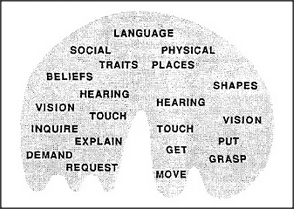# 20.8 CONNECTION LINES
The diagram below depicts a connection-scheme that permits many agents to communicate with one another, yet uses surprisingly few connection wires. It was invented by Calvin E. Mooers in 1946, before the modern era of computers. Here is how we could use just ten wires to enable any of several hundred "transmitting-agents" to activate any of a similar number of "receiving-agents." The trick is to make each transmitting-agent excite not one, but five of those wires, chosen at random from the available ten. Then each receiving-agent is provided with an AND-agent connected to recognize the same five-wire combination.

The network shown in the diagram above has a serious deficiency: it can transmit only one signal at a time. The problem is that if several transmitting-agents were aroused at once, almost all ten connecting wires would be activated, which would then arouse all the receiving-agents and cause an avalanche. However, we can make that problem disappear by providing the system with enough additional connection wires. For example, suppose there were ten thousand connection wires rather than ten, and that each transmitting-agent became attached to about fifty of them. Then, even if one hundred agents were to send their signals all at once, there would be less than one chance in a trillion that this would erroneously activate any particular receiving-agent!